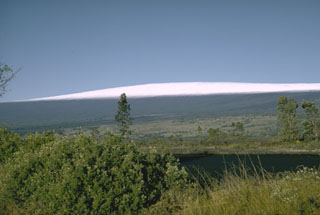Report on Mauna Loa (United States) — January 1978
Scientific Event Alert Network Bulletin, vol. 3, no. 1 (January 1978)
Managing Editor: David Squires.
Mauna Loa (United States) New fumarolic activity and increased inflation rate
Please cite this report as:
Global Volcanism Program, 1978. Report on Mauna Loa (United States) (Squires, D., ed.). Scientific Event Alert Network Bulletin, 3:1. Smithsonian Institution. https://doi.org/10.5479/si.GVP.SEAN197801-332020
Mauna Loa
United States
19.475°N, 155.608°W; summit elev. 4170 m
All times are local (unless otherwise noted)
The July 1975 eruption of Mauna Loa has been described by Lockwood and others (1976). Soon after this eruption, Mauna Loa began to inflate, and, chiefly on the basis of the historic patterns of activity, the USGS predicted that a second eruption, followed soon thereafter by a larger eruption from the NE rift, was likely to occur before July 1978. During the first half of 1977, however, local seismicity and inflation rates declined considerably, and in July 1977 the USGS issued a press release withdrawing the "before July 1978" date for the predicted eruption. Seismicity beneath the summit region has remained low, but measurements made in December 1977 indicate that the inflation rate for June-December 1977 had increased to that recorded during 1976. Furthermore, dense fume clouds have been emitted from the 1975 eruptive fissures since October 1977. The USGS has installed gas monitoring devices on one of these fumaroles and is continuing to monitor the volcano closely.
Reference. Lockwood, J., Koyanagi, R., Tilling, R., Holcomb, R., and Peterson, D., 1976, Mauna Loa threatening: Geotimes, v. 21, no. 6, p. 12-15.
Geological Summary. Massive Mauna Loa is a basaltic shield volcano that rises almost 9 km from the ocean floor to form the world's largest Holocene volcano. Flank eruptions typically occur from the lengthy NE and SW rift zones, and from the Moku'aweoweo summit is caldera, which is within an older and larger 6 x 8 km caldera. Two of the youngest large debris avalanches documented in Hawaii traveled nearly 100 km from Mauna Loa; the second of the Alika avalanches was emplaced about 105,000 years ago (Moore et al., 1989). Almost 90% of the surface of the volcano is covered by lavas less than 4,000 years old (Lockwood and Lipman, 1987). Beginning about 1,500 years ago, a series of voluminous overflows from a summit lava lake covered about 25% of the volcano's surface. Over the last 750 years, from shortly after the formation of Moku'aweoweo caldera until the present, an additional 25% of the volcano has been covered with lava flows, mainly from summit and NW rift zone vents.
Information Contacts: G. Eaton, HVO, Hawaii.

